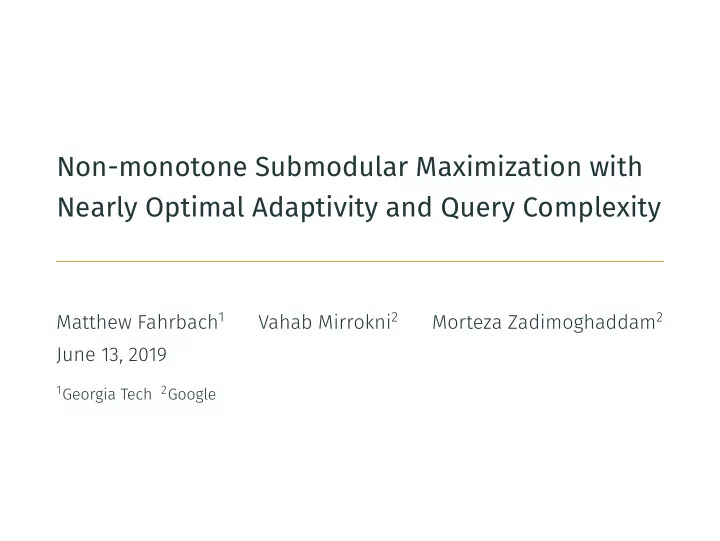

Non-monotone Submodular Maximization with Nearly Optimal Adaptivity and Query Complexity Matthew Fahrbach 1 Vahab Mirrokni 2 Morteza Zadimoghaddam 2 June 13, 2019 1 Georgia Tech 2 Google
1/4 Submodular Functions Def. A function f : 2 N → R is submodular if for all S ⊆ T ⊆ N and x ∈ N \ T we have f ( S ∪ { x } ) − f ( S ) ≥ f ( T ∪ { x } ) − f ( T ) . • Models the property of diminishing returns Example. f ( S ) is the coverage of placing sensors at locations S .
Submodular Functions Applications in machine learning. • Document summarization • Exemplar clustering • Feature selection • Graph cuts 1/4 Def. A function f : 2 N → R is submodular if for all S ⊆ T ⊆ N and x ∈ N \ T we have f ( S ∪ { x } ) − f ( S ) ≥ f ( T ∪ { x } ) − f ( T ) . • Models the property of diminishing returns
Submodular Maximization 2/4 Assumption. Evaluation oracle that returns f ( S ) in O ( 1 ) time. S f(S) Evaluation Oracle Problem. Maximize f ( S ) such that | S | ≤ k using a small number of adaptive rounds and oracle queries.
x N f S i Adaptivity Complexity 3. x 1 1 S i Set S i 1 to k : Def. The adaptivity of a distributed algorithm is the minimum 2. For i 1. Set S 0 Example. Greedy algorithm for constrained maximization • Models communication complexity with oracle • Rank of partial order on queries ordered by dependence needed round complexity, where in each round the algorithm 3/4 can make poly ( n ) independent queries to the value oracle.
Adaptivity Complexity Def. The adaptivity of a distributed algorithm is the minimum needed round complexity, where in each round the algorithm Example. Greedy algorithm for constrained maximization 3. 3/4 can make poly ( n ) independent queries to the value oracle. 1. Set S 0 ← ∅ 2. For i = 1 to k : Set S i ← S i − 1 ∪ { arg max x ∈ N f ( S i − 1 ∪ { x } ) }
Main Results BBS18 (NeurIPS 18) adaptive rounds to achieve a constant-factor approximation. FMZ19 (STOC 19) ENV19 Problem. Submodular maximization of a non-monotone CQ19 (STOC 19) 4/4 BFS16 function subject to a cardinality constraint k Algorithm Approximation Queries Adaptivity 1 / e ≈ 0 . 371 O ( k ) O ( n ) ˜ 0 . 183 O (log 2 ( n )) O ( OPT 2 n ) ˜ 0 . 172 O (log 2 ( n )) O ( nk 4 ) ˜ 0 . 371 O (log 2 ( n )) O ( nk 2 ) 0 . 039 O (log( n )) O ( n log( k )) Adaptivity Hardness [BS18]. We need Ω(log( n ) / log log( n ))
Recommend
More recommend